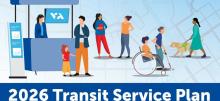Virtual Community Meeting
A Virtual Community meeting was held on June 11, 2025. You can Review the meeting here. Please join us at any of our other meetings listed below.
YouTube Recording: June 11, 2025 Virtual Community Meeting
Draft 2026 Transit Service Plan
Hello, VTA riders -- it’s that time of year again, another VTA annual service plan! The 2026 Transit Service Plan is VTA’s fourth annual plan since the 2019 Next Network redesign, and this year we look forward to providing informative updates on potential changes affecting your routes.
Although VTA faces a difficult...
Virtual Community Meeting
A Virtual Community meeting was held on June 11, 2025. You can Review the meeting here. Please join us at any of our other meetings listed below.
YouTube Recording: June 11, 2025 Virtual Community Meeting
Draft 2026 Transit Service Plan
Hello, VTA riders -- it’s that time of year again, another VTA annual service plan! The 2026 Transit Service Plan is VTA’s fourth annual plan since the 2019 Next Network redesign, and this year we look forward to providing informative updates on potential changes affecting your routes.
Although VTA faces a difficult budgeting season ahead, there are no plans to cut overall service levels. Maintaining transit reliability while adjusting service in ways that minimize impacts on riders continues to be a top priority. However, “traffic inflation” continues to slow down our service, which over time costs more resources (hours, operators, and vehicles) to keep VTA service running reliably and according to posted frequencies and schedules.
Consequently, the draft 2026 Transit Service Plan proposes very few changes from the adopted 2025 Transit Service Plan. The plan aims to balance critical changes with available operating resources. Proposed changes include:
· Changing the Route 59 end point to serve the Santa Clara Valley Medical Center campus instead of Saratoga & Stevens Creek in Santa Clara.
· Discontinuing Express Route 121 due to loss of employer sponsorship on the route.
· Keeping Rapid Route 523 at today’s conditions (i.e. 20-minute weekday frequencies).
There are no proposed changes for light rail service in 2026 (Blue, Green, and Orange Lines). VTA has already restored Saturday and Sunday light rail frequencies to 20 minutes as of April 2025.
View Details of the Draft Plan
Learn more about what is being proposed in the 2026 Transit Service Plan.
· By route
· By city
Engage with us on the Draft Plan
Have questions or want to learn more about our service planning process this year? You can find VTA staff at any one of the events below. You can also send your questions or thoughts to Customer Service by emailing customer.service@vta.org or by calling (408) 321-2300
| In-Person Meetings | Online Meetings |
|---|---|
|
Community Meeting June 17, 2026 Quinlan Community Center 10185 North Stelling Road, Cupertino, CA 6:00 p.m. to 7:30 p.m. Register: Eventbrite
|
Virtual Community Meeting June 11, 2025 6:00 p.m. to 7:00 p.m. Register: Eventbrite Zoom: https://us02web.zoom.us/j/83893598986?pwd=Q16VSlbn75s1pUHiZLpajanwV1r6bl.1 Webinar ID: 838 9359 8986 Passcode: 563099
|
|
|
VTA Planning Staff Office Hours June 26, 2025 12:00 p.m. to 1:00 p.m. Register: Eventbrite Zoom: https://us02web.zoom.us/j/82632998373?pwd=5ZWQIqQwURcTMetrIQyJbcvPz8MYjH.1 Webinar ID: 826 3299 8373 Passcode: 890629
|
Community Tabling Events
Vive Calle - June 8, 2025, Berryessa Library, 10am - 3pm
San Jose Juneteenth Festival - June 14, 2025, Downtown San Jose SoFA District, 12pm - 7pm
July 4th Celebration - July 4, 2025, Lake Cunningham Park, San Jose, 3pm-11pm
VTA Pop-Up
VTA's Downtown San Jose Customer Service Center - June 30, 2025 10:30am - 1:30pm
Farmers Markets
Sunnyvale Farmer's Market - June 28, 2025, 9am - 1pm, 121 W. Washington Street, Sunnyvale, CA
